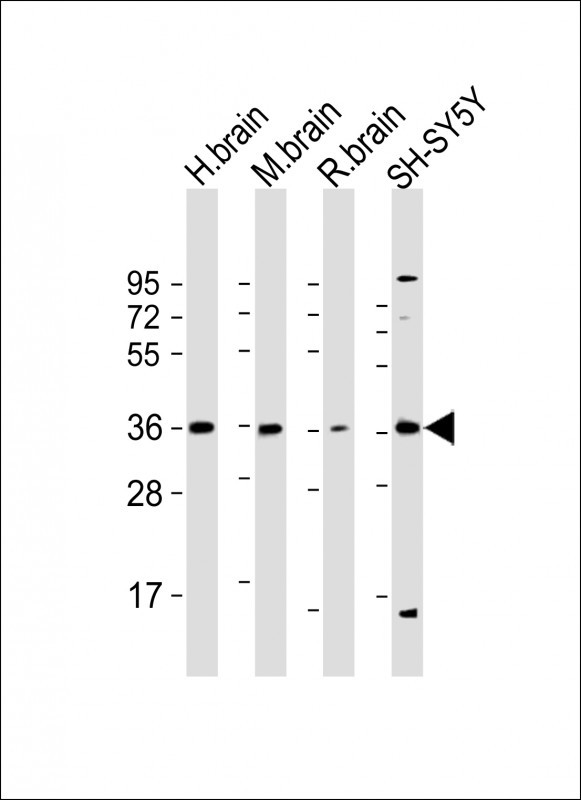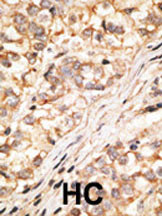


| WB | 1/1000-1/2000 | Human,Mouse,Rat |
| IF | 咨询技术 | Human,Mouse,Rat |
| IHC | 1/100-1/500 | Human,Mouse,Rat |
| ICC | 技术咨询 | Human,Mouse,Rat |
| FCM | 咨询技术 | Human,Mouse,Rat |
| Elisa | 咨询技术 | Human,Mouse,Rat |
| Aliases | Gap junction delta-2 protein, Connexin-36, Cx36, Gap junction alpha-9 protein, GJD2, GJA9 |
| Entrez GeneID | 57369 |
| WB Predicted band size | 36.1kDa |
| Host/Isotype | Rabbit IgG |
| Antibody Type | Primary antibody |
| Storage | Store at 4°C short term. Aliquot and store at -20°C long term. Avoid freeze/thaw cycles. |
| Species Reactivity | Human, Mouse, Rat |
| Immunogen | This Connexin 36 antibody is generated from rabbits immunized with a KLH conjugated synthetic peptide between 291-321 amino acids from the C-terminal region of human Connexin 36. |
| Formulation | Purified antibody in PBS with 0.05% sodium azide,1%BSA and 50% glycerol.prepared by Saturated Ammonium Sulfate (SAS) . |
+ +
以下是关于Connexin 36抗体的3篇参考文献,包含文献名称、作者及摘要概述:
---
1. **文献名称**:*"Immunochemical characterization of the gap junction protein connexin36 in mouse retina and brain"*
**作者**:J. E. Rash, T. Yasumura, C. S. Dudek, et al.
**摘要**:该研究通过免疫组织化学和Western blot技术验证了Cx36抗体在小鼠视网膜和脑组织中的特异性。结果显示,Cx36在视网膜双极细胞和神经元间电突触中高度表达,抗体在敲除模型中未检测到非特异性信号。
---
2. **文献名称**:*"Expression of connexin36 in cone pedicles and OFF-cone bipolar cells of the mouse retina"*
**作者**:S. C. Mills, S. C. Massey
**摘要**:研究利用Cx36抗体探究小鼠视网膜中锥体细胞与双极细胞的突触连接,证实Cx36在OFF型双极细胞中的特异性分布,并通过免疫电镜进一步定位其突触间隙的表达。
---
3. **文献名称**:*"Deletion of connexin36 in mice causes changes in retinal gap junction architecture and impaired visual transmission"*
**作者**:M. A. Güldenagel, A. Ammermüller, et al.
**摘要**:通过Cx36基因敲除小鼠模型,验证了多种Cx36抗体的特异性,并发现Cx36缺失导致视网膜电信号传递异常,强调了该抗体在神经电突触功能研究中的关键作用。
---
这些文献涵盖了Cx36抗体的特异性验证、组织分布研究及功能机制探索,适用于免疫组化、Western blot等实验场景。如需更多文献或具体应用细节,可进一步补充。
Connexin 36 (Cx36), encoded by the *GJD2* gene, is a gap junction protein critical for electrical and metabolic coupling between neurons in the central nervous system. As a member of the connexin family, it forms intercellular channels that facilitate direct communication, enabling synchronized neural activity, particularly in regions like the retina, hippocampus, and cerebral cortex. Cx36 is also expressed in pancreatic β-cells, where it regulates insulin secretion. Antibodies targeting Cx36 are essential tools for studying its distribution, function, and role in physiological or pathological processes.
Cx36-specific antibodies are widely used in techniques such as immunohistochemistry, Western blotting, and immunofluorescence to visualize protein localization in tissues or cultured cells. These antibodies help investigate Cx36's involvement in neural network dynamics, synaptic plasticity, and diseases like epilepsy, neurodegenerative disorders, or diabetes. Due to high homology among connexins, antibody specificity is rigorously validated using knockout models or blocking peptides to avoid cross-reactivity.
Research leveraging Cx36 antibodies has revealed its significance in retinal signaling, memory formation, and circadian rhythm regulation. Challenges remain in understanding post-translational modifications and dynamic regulation of Cx36 channels. Reliable antibodies thus remain pivotal for advancing studies on gap junction-mediated intercellular communication in health and disease.
×